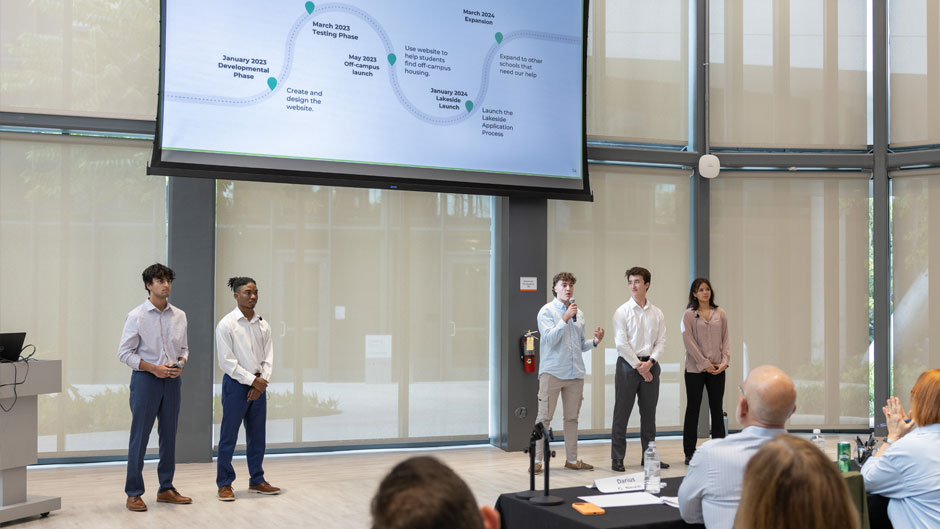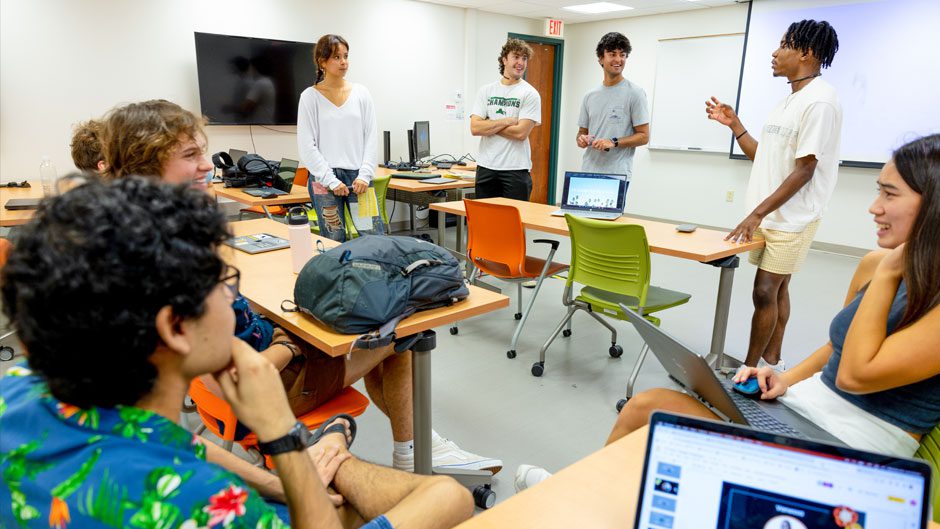By Janette Neuwahl Tannen – Guest Contributor / University of Miami
The University of Miami’s newest undergraduate degree offering in Innovation, Technology, and Design appeals to students interested in engineering, business, and hands-on experience.
Quin McGowan can recall crafting inventions at 8 years old. One of his favorites was a pulley system that he created with his brother to transport cookies to each other’s bedrooms.
A few years later, McGowan came up with the idea for a smart oven that could be controlled by a phone, so home cooks could preheat it before they got home.
So last summer, when McGowan received an invitation to take part in a new interdisciplinary major at the University of Miami, he wanted to learn more.
After attending an information session about the Innovation, Technology, and Design (ITD) program, McGowan and 21 other incoming students—who were invited based on their credentials and talents—decided to join the newest undergraduate degree program. ITD includes faculty members from subject areas across the University and aims to train students at an accelerated pace for an array of careers, as well as jobs that don’t yet exist.
“I am always coming up with business ideas, and I wanted to learn how to make them into viable solutions, but I don’t know how to go about turning an idea into an actual business,” said McGowan, who wants to eventually start his own business. “This program was the perfect intersection of everything for me.”
While the ITD degree is interdisciplinary, it is housed within the College of Engineering. And students in the program take most of their classes together. This cohort enabled the students to form bonds that began during orientation, said Neal Daniel, a first-year student and
“I like that the major is small because it creates a tight-knit group, and the fact that we see each other every day created a friendship between all of us,” said Daniel.
But he was also attracted by the program’s emphasis toward hands-on learning and skills that could translate to a variety of professions.
“I’ve been listening and taking notes my entire academic career, so I wanted something different for my college experience,” said Daniel. “Also, I knew with this major there was versatility to what I could do professionally.”
Students in the ITD program must complete at least one design challenge each semester, which typically requires creating and presenting a prototype and business plan. And ITD majors can earn their degree in just three years, but can extend their studies to four years if they want to add a Study Abroad experience, according to Derin Ural, associate dean of student affairs and professor of practice in the College of Engineering.
Students must also complete internships as part of earning the degree, since the program values experiential learning and is designed for students to be ready for the workplace at graduation.
The novel degree was created by a task force of pioneering University faculty members called the Academic Innovation Fellows, who met weekly during the past academic year to design the program, with guidance from the Minerva Project, a San Francisco-based educational company.
The ITD program pushes the envelope on a larger transition at work in colleges across the nation, said Kathi Kern, the University’s vice provost of education innovation.
“Traditionally in higher education, you prepare students by stacking courses that give them background to do more problem solving and critical thinking in their final years of college, but this program is organized so students are confronted with problems right away,” said Kern. “This program gives them foundational skills; but at the same time, it gives them opportunities to do real-world work from the start—both on campus and off campus with our industry partners and through their internships. This way, there’s a context of real-world problems where it’s not just theoretical.”
This fall, students took a design challenge class with law professor Michele DeStefano and colleague Marcia Nerine Weldon. They started by taking a professional work-style survey to understand their own style of communication and to help them understand how to collaborate with others, an area that Weldon specializes in as an employment lawyer and director of the School of Law’s transactional skills program.
Students then learned “The 3-4-5 method,” a design-thinking approach to narrow problems and create targeted solutions that DeStefano developed for legal and business professionals. These lessons helped bolster the students’ cooperation skills, honed their ability to use design-thinking strategies, and polished their presentation proficiency.
“Before this semester, standing in front of a large audience was not something I wanted to do. But now I am much more cognizant of how I look and stand, as well as how I project my voice. And that’s been very helpful,” said Daniel. “But I’ve also learned how to better interact in a team setting.”
For this semester’s design challenge, ITD students were asked to identify challenges at the University that they have experienced. Then, based on interviews and investigative research, they had to devise a solution supported by a business plan. While McGowan’s team outlined improvements for new student orientation, another team imagined the use of artificial intelligence to create future menus based on students’ preferences at University dining halls.

Kern has worked with the faculty members shepherding the ITD program and was very impressed with the students’ presentations.
“The students walked us through a multidisciplinary set of lenses on a campus problem, and I think that is pretty amazing for a first semester experience,” Kern said.
As part of the program, the first cohort of ITD students took the Design Lab class with DeStefano and Weldon. But they also took “Digital Solutions for the Future” from electrical and computer engineering lecturer Lokesh Ramamoorthi and industrial engineering lecturer Khaled Yahia Zakaria Abdel Rahman. In addition, they also had an “Innovation Design” class with communications lecturer Eddie Gomez and “Global Challenges Addressed by Engineers,” which was co-taught by several engineering professors and is required for all engineering undergraduates.
Sean Andrews, who grew up in San Diego, was energized by his first semester of ITD because he is enjoying the creativity the program offers.
“I’ve grown a considerable amount—and this class taught me time management, as well as how to better communicate my ideas,” he said. “I’ll definitely be taking the skills I learned from the classes this fall to try and start my own business.”
Ural serves as academic lead for the ITD program. Ramamoorthi is assistant program director, and Greg Levy, associate dean of academic affairs and student services at the School of Law, is the program’s experiential learning lead. After seeing the presentations, Ural was thrilled with the students’ progress.
“The ITD students were able to identify the challenges they face as UM students by engaging with all stakeholders and presented realistic solutions to the problems they faced,” said Ural, who is also one of the instructors for the “Global Challenges” course. “Now they are ready for industry-related challenges next semester.”
As the coming semester unfolds, students in the ITD program will also have a place to work on their design challenges, called the Innovation Lab. Housed on the ground floor of the McArthur Engineering Building, the collaborative space will be devoted to the ITD program, and students will have access to a range of tools—including 3D printers, state-of-the-art laptops, and LCD screens.
Students Korinne Ciechon and Roni Kennedy are both excited for the spring semester.
“I really like how the program is so hands-on and aims to give us a well-rounded education, because that’s what employers want now,” said Ciechon. “Also, the internships will help give us good opportunities to learn things that we’ll need in future jobs and throughout life.”
Visit the ITD website to learn more about the program.
This article was first published by University of Miami’s News @ The U and republished with permission
READ MORE ON REFRESH MIAMI:
- What happened in Miami tech in 2022? We’ve got the recap for you!
- Miami-based crypto platform ML Tech raises $1.9M
- For beauty and style on demand, Miami startup Glamo has you covered
- Tabit’s new US HQ in Aventura is primed for growth. We’ve got pictures
- SOAP’s animated medical assistant saves doctors time while improving patient outcomes
- Viewpoint: Where have all the Black entrepreneurs in Miami gone? - April 26, 2024
- An innovation is born: New mom and FIU student pitches her baby bottle monitor on Shark Tank - April 12, 2024
- Miami: the Dubai of the Western Hemisphere - February 20, 2024




